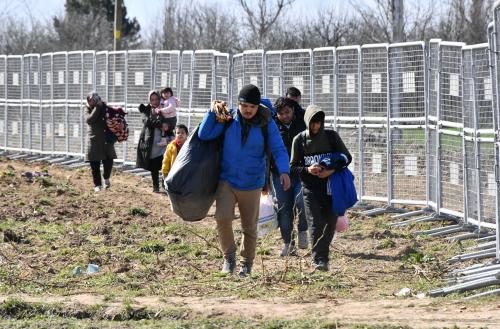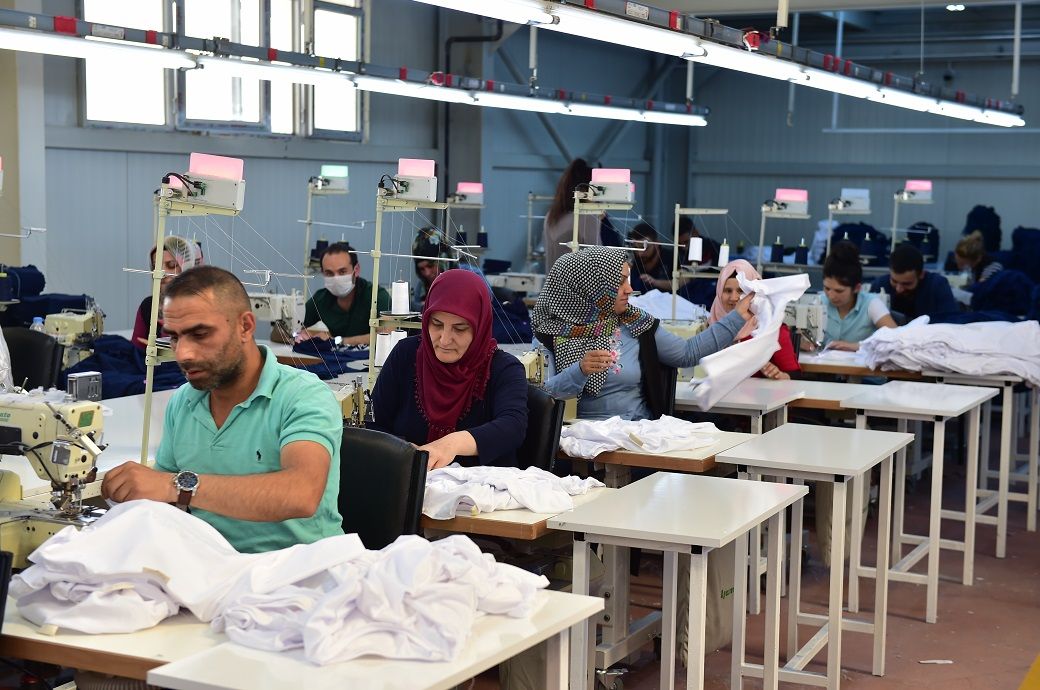As EU-Turkey migration agreement reaches the five-year mark, add a job creation element | Brookings
It has been 10 years since the conflict in Syria began to displace Syrians from their homes into neighboring countries. Since then, their numbers in Turkey have reached 3.7 million. In the absence of any traditional durable solutions — in the form of voluntary return, resettlement, or local integration — the presence of Syrian refugees in Turkey has become protracted, with no end in sight.
This “enduring reality” calls for rethinking the agreement between the European Union (EU) and Turkey that was adopted five years ago this week. Leaders should explore ways of moving it forward, focusing on development in addition to humanitarian assistance. One way to do this is to adopt policy ideas from the Global Compact on Refugees (GCR) to improve the prospects of formal employment for refugees and members of their host communities.
What did the agreement do?
The 2016 deal was adopted against the background of more than one million refugees, mostly Syrian, streaming into the EU via Turkey.
This massive secondary movement strained the very fabric of the European Union, fueling a panic that the union would be weakened “permanently and radically.” This engendered a need to urgently find an arrangement with Turkey to stop or slow down the flow of migrants. This panic coincided with growing recognition in Turkey that the prospects for refugees to return to Syria were dim, and that the cost of hosting refugees was becoming politically and economically difficult to sustain. By the end of 2015, over 2.5 million Syrian refugees were living in Turkey, and Turkey had spent close to $8 billion to aid them, with limited international support. Independently from the refugee issue, for domestic political reasons, there was also an urge on the Turkish side to use the crisis to revive the sagging EU accession process and resolve the long-standing visa liberalization issue.
In this context, both sides were compelled to negotiate first the EU-Turkey Joint Action Plan in October 2015, and then the 2016 agreement. Accordingly, Turkey would increase border security, and Greece was promised the possibility to return “all new irregular migrants” to Turkey. For each irregular migrant returned from Greece, the resettlement of one registered asylum seeker from Turkey to the EU was envisaged. Most significantly, Turkey would receive two tranches of 3 billion euros in grants to support the refugees. Finally, Turkey’s EU accession process was also to be re-energized through the opening of a new chapter, and a visa liberalization program for Turkish nationals would be pursued.
The transactional nature of the deal was met with sharp criticisms. Some called it a “dirty deal” and a cynical one, comparing it to “horse trading” at the price of “the rights and dignity of some of the world’s most vulnerable people.” Both sides complained about its implementation, as well. EU leaders were frustrated by Turkish President Recep Tayyip Erdoğan’s periodic threats to “open the borders” and let refugees stream towards Europe. Turkish officials found the funds sorely inadequate, and complained about their slow disbursement. The Turkish side also did not miss an opportunity to bitterly criticize the EU for its failure to liberalize visas for Turkish nationals and re-energize Turkey’s accession process.
Taking stock of the deal
Possibly foremost, the 2016 arrangement enabled the EU — as one prominent professor of international refugee law argued — to acquire for itself an “asylum space” outside the EU. Illegal crossings across the Aegean Sea dropped dramatically, from 885,000 in 2015 to about 42,000 in 2017. Turkey remained a “good fence” until, in February 2020, Erdoğan triggered a major humanitarian crisis at the border with Greece, finally enacting his longstanding threat of sending millions of refugees the EU’s way. However, once Greece suspended asylum procedures and forcefully prevented migrants from crossing into Greece, the crisis came to an abrupt end, just as the COVID-19 pandemic compelled the Turkish government to close its borders. During the brief period when the window was open, relatively few Syrians actually took the opportunity to attempt to leave Turkey. As precarious as their lives might be there, many refugees feel integrated: A 2019 survey showed that almost 89% of Syrians feel that they are “completely/almost completely” and “partially” integrated with their host community.
The part of the deal that directly concerns the refugees and their well-being on the ground is the Facility for Refugees in Turkey (FRIT). As of December 2020, all of the 6 billion euros in that fund have been committed and contracted, and 3.9 billion euros disbursed. Though this falls significantly short of the $40 billion that Erdoğan claimed — in a speech before the Global Forum on Refugees in December 2019 — that Turkey had spent, it supports a rich array of programs and projects. They range from cash assistance for the most vulnerable refugees to help them meet their basic needs, to those aiming to improve refugee access to public health services and integrate refugee children into the Turkish national educational system. These have increasingly been accompanied by programs aiming to improve social cohesion between refugees and their host communities, as well as expand access to livelihood opportunities. The implementation of FRIT has also created a poorly acknowledged but impressively constructive public space of cooperation between European entities (member states, the European Commission, European nongovernmental organizations) and international agencies on the one hand, and Turkish stakeholders (government agencies, municipalities, and local civil society) on the other. Although parts of the deal are deservedly criticized, FRIT has been a success and the EU should build on this success.
Although parts of the deal are deservedly criticized, FRIT has been a success and the EU should build on this success.
What next?
Moving forward, the prospects of refugees returning to their homes in Syria in large numbers and in line with U.N. High Commissioner for Refugees (UNHCR) principles looks remote. The picture for resettlement of Syrian refugees do not look very promising either. The UNHCR has projected that there will be more than 420,000 places of resettlement needed for Turkey in 2021. As of the end of November 2020, the UNHCR reported that there were only 3,867 refugee departures from Turkey, compared to 10,286 the previous November. Local integration, in the form of granting Syrian refugees a path for eventual citizenship in Turkey, has not happened either. Granting citizenship to the refugees is a very sensitive issue, with 87% of the Turkish public believing Syrians “should not be given any political rights” and 76.5% against granting citizenship. Not surprisingly, according to the only publicly available figure, there were only 110,000 Turkish citizenships granted to Syrians by the end of 2019.
Against this backdrop, access to decent and sustainable livelihood becomes paramount for refugees, and it is the missing piece today. Two structural problems stand in the way. According to the International Labor Organization (ILO), a very large proportion of the approximately one million Syrian refugees at working age are employed in the informal sector. This picture not only leaves Syrians in very precarious work and social conditions, but also exacerbates public resentment driven by falling wages and rising unemployment. Secondly, the Turkish economy is much weaker than it was when refugees began to arrive. According to the World Bank, Turkish GDP per capita dropped from its peak in 2013 ($12,614) to $9,126 in 2019, the latest available year.
The persistent problem of unemployment has now been further aggravated by the COVID-19 pandemic. The pandemic is also impacting the lives of refugees in diverse and profound ways, including their access to income and their prospects of livelihood opportunities. The Turkish Red Crescent, together with the International Federation of Red Cross and Red Crescent, found that 69% of refugees surveyed have lost their jobs during the pandemic.
What to do?
The funds allocated to FRIT have all been committed. In July 2020, the European Parliament authorized almost an additional half a billion euros, and in December the European Council promised “to continue providing financial assistance to Syrian refugees and host communities in Turkey.” However, this promise must still be negotiated internally in the EU and with Turkey. In the meantime, European Commission President Ursula von der Leyen — after her meeting with Erdoğan to end the border crisis last March — expressed a readiness to explore the “missing elements” from the EU-Turkey deal from 2016 and improve on them. Employment creation would be one such missing element.
One way to achieve this would be to create demand for refugee labor. The GCR suggests exploring “preferential trade arrangements … especially for goods and sectors with high refugee participation” to spur employment both for refugees and locals to help social cohesion. This suggestion is fully in line with trade liberalization through the reduction of tariffs, the expansion or even full elimination of quotas, and the resolution of regulatory obstacles, all of which are key drivers of economic growth and employment. Such economic growth would also help create demand for the skills and labor of refugees and compliment ongoing efforts focused on increasing their employability. In the specific case of Turkey, the European Commission had indeed flagged gaining access to “export markets … and providing preferential export and trading status to specific products” as a “priority action” for improving Syrian refugees’ self-reliance in Turkey. One specific way to put such a policy idea into action would be for the EU to grant concessions that would enable Turkey to expand its agricultural exports to the EU. Such concessions would be tied to the formal employment of Syrian refugees in a manner that meets ILO and EU labor standards.
Win-win for all
Using trade facilitation to add a job creation element to the EU-Turkey arrangement would be win-win for all. For Turkey, it would enable refugees to stand on their own feet, become productive members of Turkish society, defuse growing public resentment, and reduce the likelihood of crime out of economic desperation, while at the same time sparking some economic growth. Employment is regarded as an effective tool of refugee integration, and integration would reduce the likelihood that refugees would move to the EU, in turn benefitting it. Most importantly, refugees would benefit by being able to replace the precarity of informal employment with the dignity that would come with self-reliance based on sustainable employment. Finally, this would be a concrete manifestation that burden-sharing — in line with the letter and spirit of the GCR and the 1951 Geneva Convention, as it approaches its 70th anniversary — is still alive.




